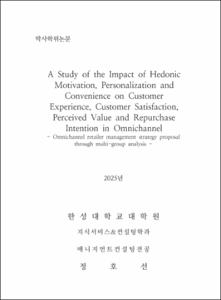A Study of the Impact of Hedonic Motivation, Personalization and Convenience on Customer Experience, Customer Satisfaction, Perceived Value and Repurchase Intention in Omnichannel
= 옴니채널에서 쾌락적 동기, 개인화와 편리성이 고객 경험, 지각된 가치, 고객 만족과 재구매 의도에 미치는 영향에 관한 연구 : 멀티그룹분석을 통한 옴니채널 리테일러 경영전략 제안
- Type
- Thesis
- Alternative Title
- Omnichannel retailer management strategy proposal through multi-group analysis
- Department
- 대학원 지식서비스&컨설팅학과
- Issued Date
- 2025
- Publisher
- 한성대학교 대학원
- Appears in Collections:
- 지식서비스&컨설팅학과 > 1. Thesis
- Files in This Item:
-
-
Download
 200000861970.pdf
기타 데이터 / 1.65 MB / Adobe PDF
200000861970.pdf
기타 데이터 / 1.65 MB / Adobe PDF
-
Items in Repository are protected by copyright, with all rights reserved, unless otherwise indicated.